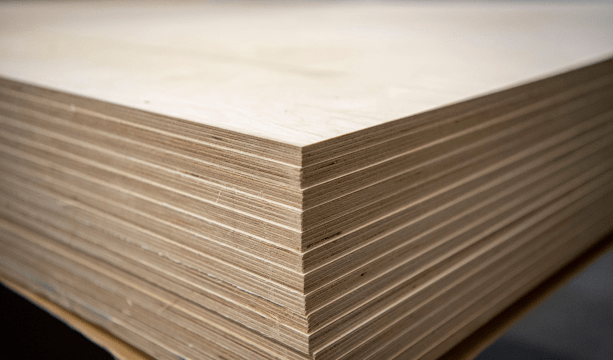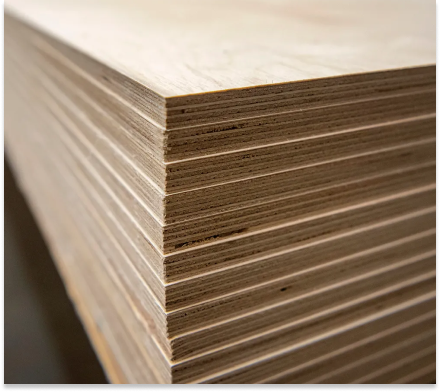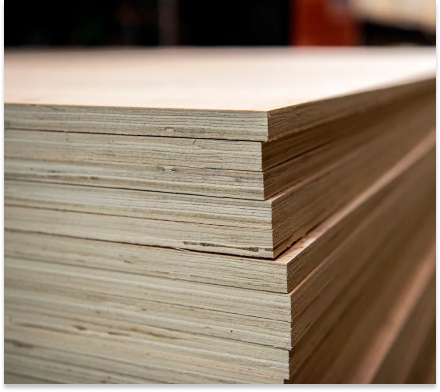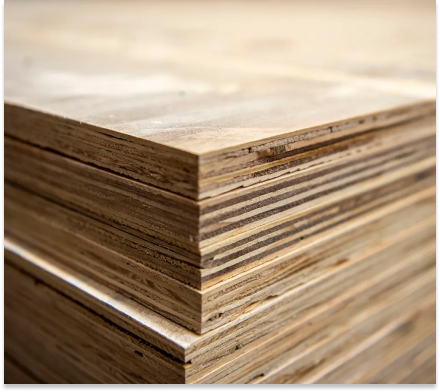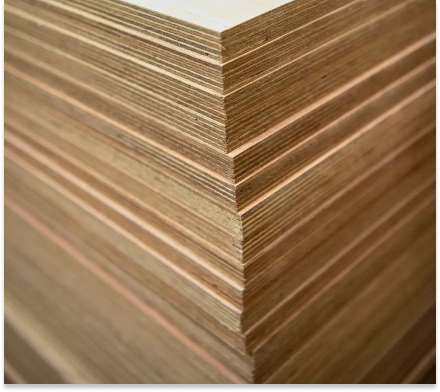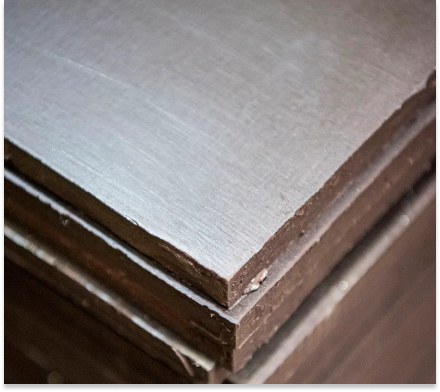How is plywood made?
Plywood is made out of wood veneers that are glued together to produce a solid sheet. Plywood sheets are a strong, affordable and versatile material used for a different range of structural, internal, external and marine purposes. There are many different types of plywood for different applications.
As well as this, Plywood is graded into 4 groups:
- Class 1 – Strictly internal
- Class 2 – Interior grade of humid conditions but must be sealed
- Class 3 – Exterior grade but must be sealed
- BS1088 – Marine
You can read more about plywood service classes in our UK plywood standards guide.
In order to form a stable sheet, plywood sheets are made out of a number of layers, such as three or five ply, surrounding the central core. The veneers should be of similar species and thickness however, the core can be thicker.
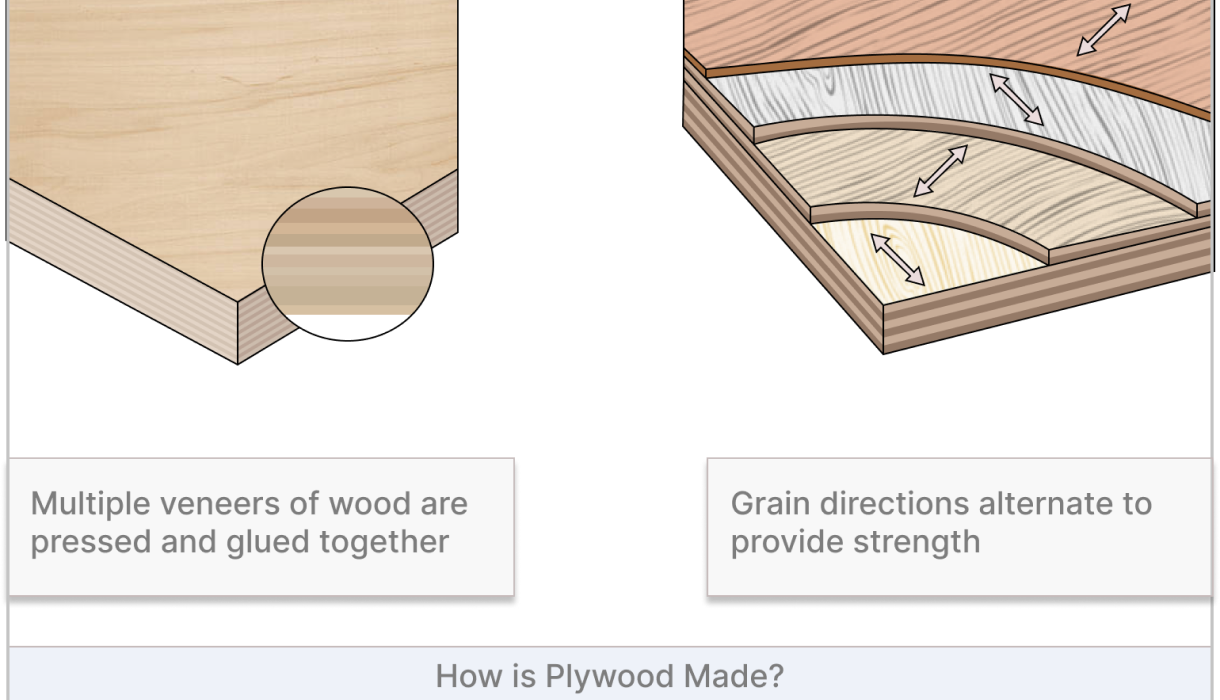
Usually the thinner the ply, the more flexible the sheet is. Look out for plywood sheets that are made to an exterior grade known as WBP plywood (weather and boil proof). This means that the adhesive used to bond the individual veneers together will not break down in adverse weather conditions.
Plywood Types and Uses Summary
Plywood Types in Profile
Features: Birch plywood is a popular and high quality wood with fine grain texture. It is made out of birch veneers that are bonded and layered in alternating directions up to the required thickness.
Standard range of birch ply varies in thickness along with the grading. The popular 18mm birch plywood offers great quality hardwood at an affordable cost. Birch ply that is birch throughout plywood is known for it's strength and stability. Be aware of some suppliers offering alternating face grades like BB/BB and BB/CP. Generally, the best grade is B/BB for good finish and clean appearance.
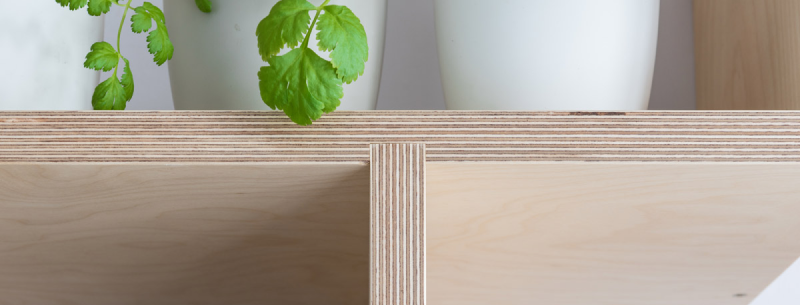
Application: Birch plywood consists of a plain hardwood panel that has a smooth and neat finish often used as a home improvement material. Especially popular in furniture making and high end packaging here we list some of the reasons for its popularity:
Aesthetic Look - It has a an elegant finish with very few knots giving you a wide choice of application methods. Depending on the look you wish to achieve, it can be left untreated or it can be stained.
Durability - Strength and stability comes from the engineering process in which the layers of birch are formed.
Safety - Thanks to its engineered construction the edges are not known to crack, shrink or splinter. This type of wood is therefore perfect in furniture making and as a good material for children’s toys.
Sustainability: Birch trees are a fast growing species of wood widely available in the northern hemisphere. This makes it plentiful as a renewable source with less impact on the environment.
Features: Hardwood plywood is manufactured from thin timber layers that are glued, trimmed and sanded. There are structural and non-structural boards. Structural grading is achieved by rigorous testing by a third party. 9mm thickness and above is classed as structural.
In order to meet structural standards these boards have to be produced from phenol formaldehyde resin which creates a glue bond that won't weaken in wet conditions or during temperature changes. The non-structural boards are produced from urea formaldehyde resin and are not suitable for structural or outdoor use unless all sides and edges are suitably protected and treated with a preserver.
Non-structural hardwood plywood is aesthetically pleasing enough to be used within interiors.
This type of plywood has a face and back veneer made out of hardwood. However, the core of hardwood sheets can sometimes be made out of softwood such as pine, cedar or spruce. Hardwood boards that are hardwood throughout, make them a stable and solid material perfect to be used as building boards.
Also excellent for construction, hardwood plywood panels are known for their durability and strength combined with their smooth sanded surface, which is resistant to warping and bending. Look for hardwood plywood that conforms to EN636-2 and EN314-2 building standards (class 2). They are generally available in a variety of thicknesses.
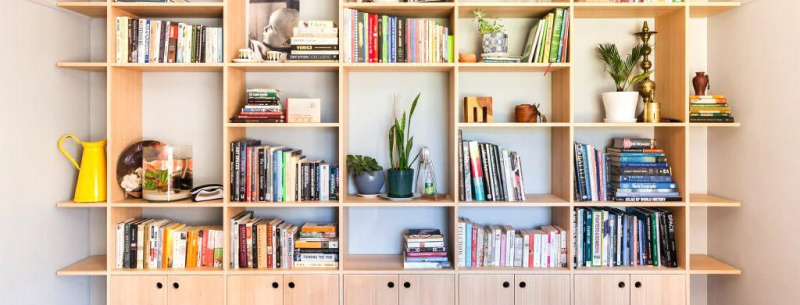
Types of Hardwood Plywood: There are many types available in many grades and species. The best hardwood plywood comes in B/BB grade. It can be of mixed light hardwood species however, beech, maple and walnut in particular offer some aesthetic advantages such as colour and woodgrain. These types of hardwood are therefore used widely in joinery production and furniture making.
This type of plywood is widely used in the construction industry because when suitably protected and treated with an appropriate preserver even the non-structural boards remain stable and can be used externally as well. The knot free B face can be clear-finished by using varnish or polyurethane to highlight and enhance the attractive wood grain surface.
Hardwood is also used in furniture manufacturing thanks to its veneer finish and stain grading. Therefore, it is ideal to use in millwork, including cabinet making, joinery and shelving. The durability and superior quality, generally means that hardwood ply is more expensive than softwood.
Hardwood for Other Applications: Hardwoods are also popularly used as interior wood mouldings. Hardwood decorative mouldings offer a great way to finish off your doors, walls or windows. Hardwoods such as oak are a particularly popular material to use for skirtings and architraves thanks to their stylish yet strong finish.
Features: Softwood plywood panels have a core made out of softwood and are also faced and backed with a veneer of softwood. They are used for a wide range of internal and external projects thanks to their versatility, strength and aesthetic advantage.
There are many different grades and thicknesses of softwood plywood. The highest grades can be used for decorative purposes such as furniture making. The C+ face is sound but could have some knots and open splits which will require filling to produce the best results. All good softwood plywood is made with moisture resistant glue such as phenol resin adhesive. If you purchase exterior grade panels, these have been waterproofed and are usable for outdoor structures.
Types of Softwood: Softwood Plywood is generally made out of pine. Spruce can also be used depending on the country of manufacture. Sourced from all over the globe softwoods are considered to be an affordable and easily available source of material. In fact most of the wood used across the globe is softwood.
Application: Softwood is used for structural applications within the construction industry. It is suitable for projects and manufacturing such as walls, roofs, fencing, windows and flooring.
It is easily worked with hand or power tools as it screws, glues and paints well. When sawing, support the panels firmly with the best face up. Cut with the best side down when using a portable power saw. Do not force-feed the panel into the tool or the tool into the panel too quickly because this will increase the roughness of the cut and may induce splintering-out on the exit side. Proper backup of the material can also help to reduce splintering.
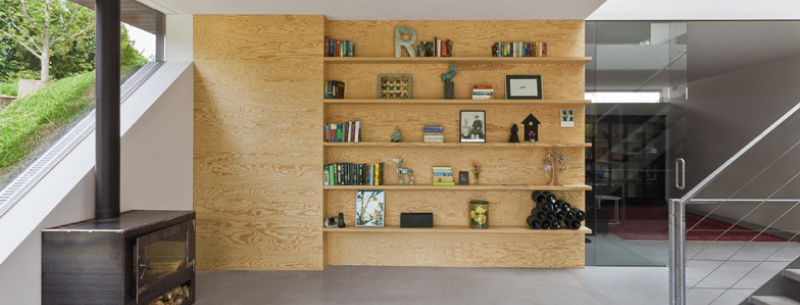
Softwood for Other Applications Also popularly used for decorative purposes such as for interior timber mouldings. Softwood decorative mouldings offer a neat way to finish off your doors, walls or windows. Softwood is also used to make skirting boards and architraves. These don't tend to be as popular as MDF skirting boards or MDF architraves but softwood offers stability and quality at an affordable price.
Features: Marine plywood or marine grade plywood, is a quality hardwood that is structural plywood made with waterproof glue called WBP which stands for weather and boil proof. The use of WBP means that the plywood layers will not delaminate or detach when exposed to moisture, humidity or even boiling temperatures. This helps keep the plywood structurally intact. It can also be treated with chemicals for a more water-resistant finish offering even longer protection to decay when exposed to moisture.
Marine ply is available in different grades from A-A, A-B, B-B, MDO to HDO. In general the better the grading the stronger and more lightweight the plywood is.
Marine plywood is considered high quality because it is made with hardwood throughout. This type of plywood is achieved by layering multiple thinner layers of veneer resulting in denser panels without any voids or holes. Marine ply is more expensive but it will last longer in severe conditions.
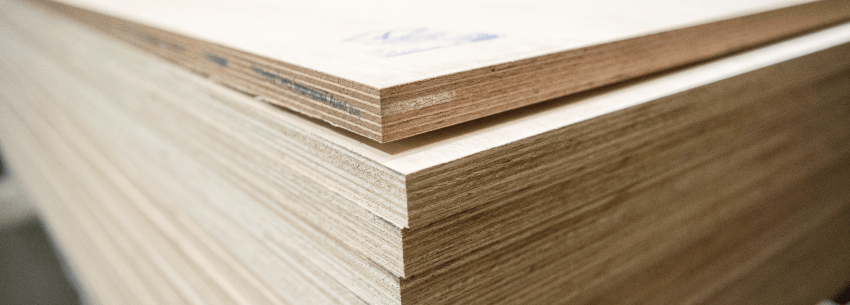
Application: Marine plywood is designed to be used externally and specifically manufactured for harsh marine environments. Good quality marine plywood is BS1088 compliant which is the standard set by Marine Insurers. As a result it can be used as a building material in the ship and boat industry. In order to conform to these standards the marine plywood also needs to be void and hole free throughout.
It is also considered an option for outdoor furniture such as garden tables, chairs and benches. For bigger outdoor projects, such as porches or decking, marine plywood is an ideal choice. Once a protective finish such as a sealer has been applied it can also be used in coastal areas, including in boat docks.
How do I seal marine grade plywood?
You will need to treat every surface of the wood with a sealant after sanding all the sides and edges of the board. If you require plywood that does not need an additional protective finish, choose plywood that is already rated for the expected level of moisture. See a range of pressure treated timber instead.
For sanding we recommend using 80-grit sandpaper combined with a cloth to clean up the dust and debris afterwards.
Next, ensure you are sealing the entire sheet using a foam brush to spread the protector. It is best to use a clear penetrating epoxy moisture sealer that will embed deep into the sheet. We recommend using Rustins Yacht Varnish in clear gloss specially formulated for marine woodwork. Start from the edges and coat one side allowing the sheet to dry before turning it and coating the other side.
Re-apply as many coats as there are layers of ply. In between each coat lightly sand the surfaces to slightly rough up the sheet for the next coat to apply easier. When all the coats are applied your marine plywood is protected and sealed ready for the harshest of conditions.
Features: Shuttering plywood is a highly densified type of plywood that has at least nine layers of veneer, which are machine-pressed at high temperatures. The face and back panels both have a smooth film coating making shuttering plywood strong enough to hold heavy loads such as concrete or a ceiling.
Shuttering plywood of at least 12mm in thickness will ensure it is able to support the heavy loads required. It is the most affordable of plywoods, which still meets the building standards EN636-3. Shuttering ply is available in softwood suitable for single use and can also be found phenolic faced which can be used multiple times.
Application Shuttering ply is mostly used in construction work. It can be used in work such as creating bases for highways, drains and pillars. It is also ideal for setting up the ceiling and walls as well as holding cement while it sets in place. Concrete can be poured on top of the plywood in order to shape it as required.

